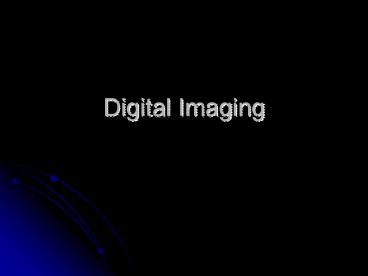Digital Imaging - PowerPoint PPT Presentation
1 / 17
Title:
Digital Imaging
Description:
1. Look at the two gratings on the right side of the figure. ... 1 Kilobyte (KB) = 1,024 bytes. 1 Megabyte (MB) = 1,024 KB. 1 Gigabyte (GB) = 1,024 MB ... – PowerPoint PPT presentation
Number of Views:48
Avg rating:3.0/5.0
Title: Digital Imaging
1
Digital Imaging
2
Digital Images
- Can be produced by
- Digital cameras
- Scanner
- The Internet
3
Digital Images
- Images are mapped on a grid
- Pixels are picture elements
- Dots fill the grid
- Can be black, white, grayscale or color
- Binary code
- Series of 0 and 1
4
Binary Digits
- Binary Digital are called bits
- Bits are stored sequentially
- Computer interpret them into analog
5
Resolution
- Ability to see fine detail
- Dots per inch (dpi)
- Pixels-per-inch (ppi)
Individual pixels can be see by viewing the image
6
1. Look at the two gratings on the right side of
the figure. Do you see any differences between
them? 2. Now for about 60 seconds scan your gaze
back and forth along the horizontal red bar
between the two gratings on the left. 3. When
you are finished scanning back and forth along
the horizontal red bar, fixate on the short red
bar between the gratings on the right. 4. What
differences do you see between these two gratings
on the right compared to the first time you
looked at these gratings?
7
Spatial Frequency Adaptation
The two gratings on the right, when you looked at
them the first time, undoubtedly appeared
identical. When you scanned the red bar between
the two gratings on the left you allowed your
visual system to adapt to these gratings. The
adaptation was not the same for the top and
bottom grating because they differ in spatial
frequency. The one on the bottom has a higher
spatial frequency than the one on top. Then after
adapting to the gratings on the left for
approximately 60 seconds the ones on the right if
viewed while fixating between them on the red
square probably no longer appear identical. This
non-identity will not last for too long.
8
Spatial Scales
9
Pixel Dimensions
- the horizontal and vertical measurements of an
image expressed in pixels. - may be determined by multiplying both the width
and the height by the dpi - digital camera also uses pixel dimensions
- the number of pixels horizontally and vertically
- define as its resolution (e.g., 2,048 by 3,072)
- Calculate the dpi achieved by dividing a
document's dimension into the corresponding pixel
dimension against which it is aligned.
10
Pixel Dimensions
Example
An 8" x 10" document that is scanned at
300 dpi has the pixel dimensions of 2,400 pixels
(8" x 300 dpi) by 3,000 pixels (10" x 300 dpi).
Example An 8" x 10" document that is scanned at
300 dpi has the pixel dimensions of 2,400 pixels
(8" x 300 dpi) by 3,000 pixels (10" x 300 dpi).
11
Question Time
What are the pixel dimensions of a 5x7-inch
photograph scanned at 400 dpi? Answer (check
one) ? 2,000 x 2,800 pixels ? 1,300 x 1,800
pixels
The correct answer is 2,000 x 2,800 (5 X 400
2,000 and 7 X 400 2,800)
12
Question Time
If an 8.5x11-inch page is scanned and has pixel
dimensions of 2,550 x 3,300, what is the dpi?
dpi
Calculate the dpi by dividing one of the
document's dimensions into the corresponding
pixel dimension, e.g., 2,550 divided by 8.5 300
dpi.
13
- File size naming convention Because digital
images often result in very large files, the
number of bytes is usually represented in
increments of 210 (1,024) or more - 8 bits 1 byte
- 1 Kilobyte (KB) 1,024 bytes
- 1 Megabyte (MB) 1,024 KB
- 1 Gigabyte (GB) 1,024 MB
- 1 Terabyte (TB) 1,024 GB
14
Document Types
Printed text manuscript halftone continuous
tone mixed
15
Document Types
- Printed Text/Simple Line Art
- distinct edge-based representation
- no tonal variation
- such as a book containing text
- simple line graphics
- Manuscript
- soft, edge-based representations
- produced by hand or machine
- do not exhibit the edges typical of machine
processes
16
Document Types
- Halftones
- reproduction of graphic or photographic materials
- regularly spaced pattern of dots or lines
- often placed at an angle
- Includes some graphic art as well, e.g.,
engravings - Continuous Tone
- items such as
- photographs,
- watercolors,
- and some finely inscribed line art
- exhibit smoothly or subtly varying tones
17
Document Types
- Mixed
- documents containing two or more of the
categories listed - Example illustrated books































